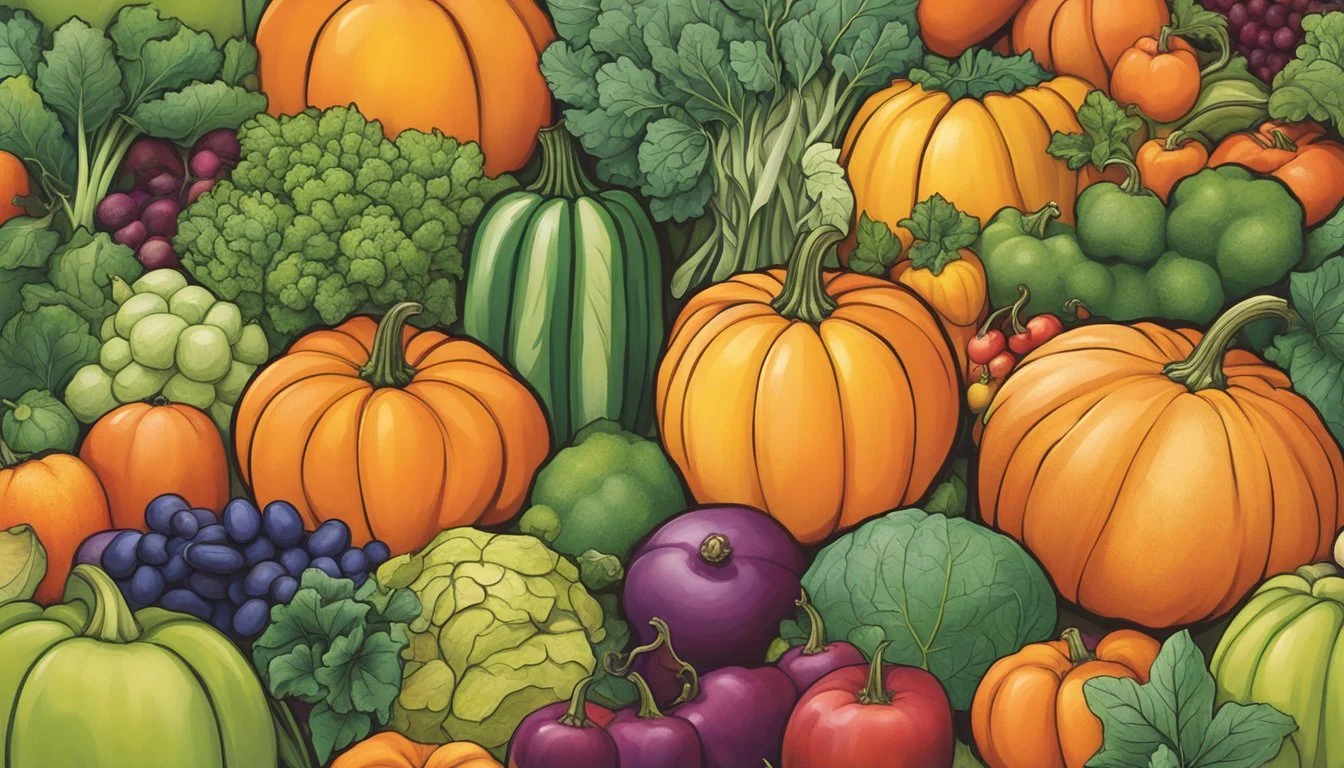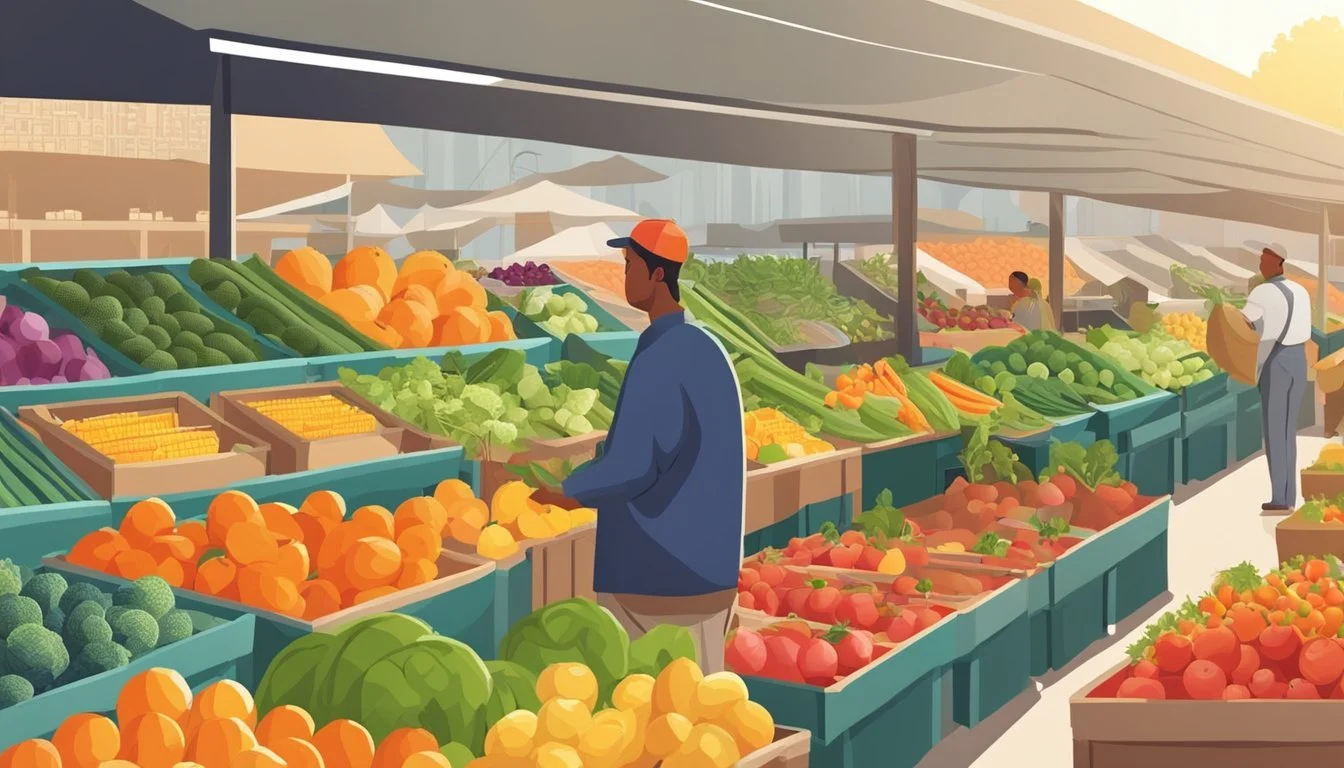Oklahoma Seasonal Fruit & Vegetables in November
A Guide to Local Produce
This Article is Part of our Oklahoma Seasonal Fruit & Veg Calendar
In Oklahoma, November marks a time of transition as the state welcomes the end of fall and prepares for the onset of winter. This month is characterized by a rich tapestry of seasonal produce that not only sustains the local cuisine but also supports the state's agricultural heritage. Farmers and home gardeners alike harvest a variety of fruits and vegetables that are at their peak during this period, ensuring fresh and flavorful ingredients are available for the Thanksgiving table and beyond.
The cooler temperatures of November influence the types of produce that are available in Oklahoma. Root vegetables and hardy greens take center stage, offering robust flavors and nutrition. This is also the season when late fall fruits find their way into local markets, providing a last burst of natural sweetness before the winter chill sets in. The seasonal produce of November not only reflects the rich soil and farming practices of the region but also the adaptability of local farmers to the changing environment.
Oklahoma's seasonal offerings in November include a variety of produce that is perfect for hearty soups, stews, and holiday dishes. Root vegetables like sweet potatoes, (What wine goes well with potatoes?) carrots, and turnips are bountiful, as are winter squashes such as acorn and butternut squash (how long does butternut squash last?). Greens like kale (What wine goes well with kale?) and collard greens (how long do collard greens last?) remain steadfast in gardens, and some fruit trees give their final yield of apples (how long do apples last?) and pears. These seasonal fruits and vegetables are more than just food; they are a celebration of Oklahoma's agricultural rhythm and culinary traditions.
Understanding Seasonality
In Oklahoma, the transition from fall to winter significantly influences the availability of seasonal produce. Seasonality refers to the times of year when specific fruits and vegetables are at their peak in terms of flavor and abundance. This is dictated by the local climate and growing conditions which, in turn, are recorded on harvest calendars for consumer knowledge.
During November, growers and consumers alike witness a shift in the type of produce that is harvested. This is a time when late fall crops are still available and early winter offerings begin to appear. The seasonal calendar is an essential tool for anyone interested in consuming fresh food that aligns with the natural growing cycles.
Fruits and vegetables that thrive in cooler temperatures come into prominence. Here is a condensed list of produce one might find in Oklahoma during this month:
Vegetables:
Brussels sprouts (how long do brussels sprouts last?)
Sweet potatoes
Winter squash
Pumpkins
Turnips
Fruits:
Apples
Pears
Understanding seasonality is key for those who seek to eat freshly harvested produce, support local agriculture, and potentially enjoy the health and environmental benefits of consuming food that has not been shipped from afar. Local farmers' markets and grocery stores tend to offer these seasonal selections, giving consumers the opportunity to partake in the freshest produce available.
Fruits in Season
In November, a select variety of fruits ripen across Oklahoma, offering a range of flavors from the tartness of cranberries to the sweet, honeyed taste of persimmons.
Tree Fruits
Apples: Late-season varieties flourish in November, with options ranging from tart to sweet. Consumers might find local favorites such as Fuji, Granny Smith, and Braeburn readily available.
Fuji: Sweet and crisp, ideal for eating fresh or baking.
Granny Smith: Tart and firm, perfect for pies and salads.
Braeburn: Balanced sweet-tart flavor suitable for a wide range of dishes.
Pears: This fruit also offers diversity with several types reaching peak ripeness. Bartlett pears, known for their juicy sweetness, are typically easy to find.
Bartlett: Soft and sweet, great for eating raw or in preserves.
Persimmons: The state witnesses the persimmon season, where both the native American persimmon and the Fuyu variety are common. These fruits present a sweet, almost cinnamon-like profile.
American Persimmon: Soft when ripe, with a rich and honeyed flavor.
Fuyu Persimmon: Crunchy and sweet, eaten like an apple.
Pomegranates: While not as widely available, pomegranates make a brief appearance offering their jewel-like seeds that burst with tangy juice.
Berries and Citrus
Cranberries: Although not typically grown in Oklahoma, fresh cranberries may be sourced from cooler climates and arrive in stores in November, in time for the holiday season.
while citrus fruits are not commonly harvested in Oklahoma in November, residents often enjoy varieties transported from warmer regions.
Seasonal Vegetables
In November, Oklahoma's harvest offers an abundant variety of vegetables that are both rich in flavor and nutrients. During this time, residents can indulge in a selection of root vegetables, leafy greens, cruciferous vegetables, and a diverse array of other seasonal offerings.
Root Vegetables
Root vegetables thrive in the cooler temperatures of Oklahoma's fall season, providing hearty flavors and essential fiber. The state's soil yields a bountiful harvest including:
Potatoes
Sweet Potatoes
Carrots
Beets
Radishes
Sunchokes
Turnips
Leafy Greens
The crisp weather is conducive to the growth of lush greens, which can be enjoyed raw or cooked.
These greens are known for their versatility and are packed with vitamins.
Cruciferous Vegetables
November is an ideal month for the cruciferous family, noted for their health-promoting properties.
Cabbage
Brussels Sprouts
Broccoli
Cauliflower
Each offers a unique taste and texture, enhancing any fall dish.
Other Vegetables
This month also provides an array of other vegetables that can add depth and variety to meals.
Winter Squash
Onions
Leeks
Garlic
Celery
Fennel's anise-like flavor and the robustness of garlic are particularly notable during this season.
Herbs and Other Produce
In Oklahoma, November marks a shift in the growing season. Gardens typically transition to heartier crops that can withstand the cooler temperatures. Herbs such as sage, rosemary, and thyme are in good supply. They are resilient against the chill and thrive in the state's climate at this time. These herbs add a fragrant touch to the seasonal fare and often feature prominently in holiday cuisine.
Available Herbs
Sage: Known for its earthy flavor, sage is a staple in Thanksgiving recipes.
Rosemary: Hardy and with a pine-like aroma, rosemary is excellent for roasting dishes.
Thyme: This versatile herb infuses meals with a subtle, savory essence.
Aside from these culinary herbs, Oklahoma gardeners may grow other cold-tolerant produce during November. While fruits are less abundant, some hardy vegetables and greens make it to the tables:
Other Produce
Vegetable Description Winter squash Rich in flavor; varieties include acorn and butternut. Kale Nutrient-dense and excellent for salads or cooking. Swiss chard Colorful greens that are both tasty and nutritious. Collard greens A southern classic, often cooked slowly with rich flavors.
The farmers in Oklahoma ensure a diversity of produce remains available despite the cold. They utilize techniques like hoop houses to extend growing seasons and protect delicate plants from early frost. While the array of produce may not be as vibrant as the summer months, November still provides a bounty that supports healthy eating and local agriculture.
Oklahoma's Season-Specific Challenges
In November, Oklahoma's climate presents several challenges for growing fruits and vegetables. The region experiences considerable variability in terms of temperature and precipitation, which can affect crop yields and harvesting schedules.
Temperature: As winter approaches, the temperatures in Oklahoma can drop significantly, leading to the first frosts of the season. These conditions can halt the growth of sensitive plants or even damage them.
Protection: Growers often use various methods to protect their crops, such as:
Row covers
Mulching
Windbreaks
Precipitation: Rainfall in November can be unpredictable, ranging from sudden heavy downpours to extended dry spells.
Irrigation: During dry periods, consistent irrigation is crucial, whereas proper drainage is necessary to prevent root rot and other issues during heavy rains.
Region-Specific Issues: Oklahoma's diverse topography means that agricultural challenges can vary widely from one area to another.
Soil Conditions: The soil quality may differ, with some areas having soil that retains moisture well, while others may have sandy or clay-heavy soil that presents different growing challenges.
Wind: In some parts of the state, strong winds can damage crops and erode topsoil, requiring the use of windbreaks and strategic planting.
Farmers must remain vigilant and adaptable, as the fluctuations in climate and diverse regional characteristics of Oklahoma demand a tailored approach to crop management during the month of November.
Selecting and Storing Seasonal Produce
When shopping for seasonal fruits and vegetables in November, consumers are advised to visit local Oklahoma grocery stores or farmers' markets for the freshest options. Produce selected during this time is likely to have reached peak maturity, ensuring the best flavor and nutritional content.
Look for produce that feels firm and appears vibrant and free of blemishes or soft spots.
Greens should be bright and crisp, not wilted or discolored.
Root vegetables like turnips and sweet potatoes should be solid without any sprouts or green spots.
Storing for Freshness:
Refrigerate leafy greens, broccoli, and cauliflower in crispers to maintain humidity and freshness.
Store onions and garlic in a cool, dark place with ventilation to prevent sprouting.
Winter squash can remain at room temperature in a dark, cool space; once cut, refrigerate the exposed surfaces to prevent spoiling.
Seasonal November Produce in Oklahoma:
Fruits Storage Tips Apples Refrigerate in a plastic bag for up to 6 weeks. Pears Ripen at room temperature, then refrigerate.
Vegetables Storage Tips Sweet potatoes Store in a cool, dark, well-ventilated place; not in the refrigerator. Winter squash Keep in a cool, dark area for up to a month. Turnips Remove greens and store separately; refrigerate both in plastic bags.
Consumers should remember that cool temperatures slow down the ripening process and can preserve freshness, while proper ventilation can prevent spoilage from moisture build-up. By selecting carefully and storing produce correctly, shoppers can enjoy the full bounty that Oklahoma's November harvest has to offer.
Culinary Ideas and Recipes
November in Oklahoma brings an abundance of seasonal vegetables that inspire warmth and comfort in culinary crafting. Grocery stores and farmers' markets teem with fresh produce like squashes and root vegetables.
Salads: One can capitalize on crisp, fresh greens such as kale and spinach, both of which are in season. They provide a sturdy base for a hearty Autumn Salad, best accentuated with roasted seeds, and perhaps a sprinkle of goat cheese for a tangy contrast.
Soups: Root vegetables, like sweet potatoes and parsnips, shine within the cozy confines of a blended soup. They recommend a Sweet Potato & Parsnip Soup, infused with ginger for warmth and garnished with crispy parsnip chips for texture.
Below is a tabulated reference for the pairings of these vegetables with various herbs and spices that could enhance their natural flavors:
Vegetable Herbs & Spices Squash Sage, nutmeg (how long does nutmeg last?) Parsnips Thyme, black pepper Potatoes Rosemary, garlic Kale Garlic, red pepper flakes (how long do red pepper flakes last?)
Main Dishes: A Stuffed Acorn Squash can become a centerpiece, with a filling of wild rice (how long does wild rice last?), cranberries, and pecans, embodying the essence of November.
In addition to crafting individual recipes, they encourage using the diversity of seasonal produce to create vibrant and nourishing meals, allowing the natural flavors to come to the forefront in a confident, clear fashion that speaks directly to the heart of autumnal cooking.
Benefits of Eating Seasonally
Eating seasonally offers numerous health and environmental advantages. Consumers who choose seasonal produce enjoy the peak of flavor and nutrition. Freshness is paramount, as locally harvested foods retain more nutrients than those that have traveled long distances. For instance, Oklahoma's fall selections, such as apples and pumpkins, are not only packed with flavor but also rich in fiber and essential vitamins.
Nutritional Value: Seasonal fruits and vegetables, harvested and consumed during their appropriate times, tend to have a higher nutritional content. For example, vegetables like sweet potatoes and greens are full of vitamins when they are fresh. The closer a consumer can get to the time and place of harvest, the more nutritious their food is likely to be.
Environmental Impact: Seasonally eating supports local agriculture and reduces the carbon footprint associated with shipping foods from afar. It encourages a sustainable food economy and helps in the preservation of the local ecosystem.
Variety in Diet: Consuming produce by the season ensures a diverse diet throughout the year. This diversity contributes to a well-rounded intake of health-promoting phytonutrients and minerals.
Health Benefits: Lastly, eating seasonally aligns with the body's nutritional needs. During colder months, the body benefits from high-fiber, heartier produce that provides energy and warmth. Pumpkins and apples, fall staples, are prime examples of seasonal foods that support health during their respective season.
By emphasizing seasonal eating, individuals can enjoy fresh food, high in fiber and optimized for the season, which supports their overall health.
Where to Find Seasonal Produce
In Oklahoma, November brings a variety of seasonal produce to the table. Residents can find these fresh ingredients at several locations across the state. Grocery stores, farmers markets, and U-Pick farms offer an abundance of seasonal selections that cater to conscious consumers seeking freshness and local flavor.
Grocery Stores: Most grocery stores in Oklahoma stock seasonal fruits and vegetables. They typically source from local farmers to provide fresh and seasonal produce to their customers. Shoppers might find pumpkins, sweet potatoes, and winter squashes prominently displayed.
Featured Produce: Pumpkins, Sweet Potatoes, Winter Squash
Farmers Markets: For those looking to support local agriculture, farmers markets are the place to visit. They often host a variety of local farmers and producers, offering a direct connection to the Oklahoma harvest. Markets in Oklahoma City, Tulsa, and other areas provide not only seasonal produce but also a community atmosphere.
Farmers Market Locations: Oklahoma City, Tulsa, Norman
U-Pick Farms: Individuals can experience harvesting their own fruits and vegetables at various U-Pick farms throughout Oklahoma. These farms allow visitors to select and pick their own produce, ensuring the freshest quality and an enjoyable farm-to-table experience.
Popular U-Pick Produce: Apples, Persimmons
Consumers are encouraged to reach out to these locations directly or visit their websites for the most up-to-date information on available produce and operational hours. By visiting grocery stores, farmers markets, and U-Pick farms, Oklahomans can easily incorporate the freshest local ingredients into their November meals.









